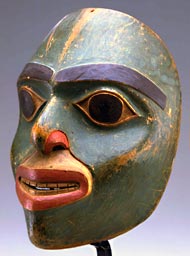New Gallery for Native North American Art Opens at Metropolitan Museum, Rare Copper Mask on Display
 The New Gallery of Native North American People opened November 13 at the Metropolitan Museum of Art, featuring a rare copper mask by a Haida artist.
The New Gallery of Native North American People opened November 13 at the Metropolitan Museum of Art, featuring a rare copper mask by a Haida artist.Photograph courtesy of Naomi Takafuchi
A new gallery celebrating the art of Native North American people recently opened at The Metropolitan Museum of Art on November 13. After three years of renovation, the enlarged gallery displays a greater number of Native American works of art than ever before seen at the Museum. A select group of approximately 90 works present the art of various North American peoples, regions, and time periods in which distinct cultural, stylistic, and functional aspects are shown. The objects range from the beautifully shaped and finished stone tools known as bannerstones that date back several millennia to a mid-1970s tobacco bag made by the well-known Assiniboine/Sioux beadwork artist Joyce Growing Thunder.
Notable works include a Kwakwaka'wakw piece, probably the work of a Haida artist, which is unusual because its primary material is copper. Copper was much valued among Northwest Coast peoples, and in this instance the incised patterns of killerwhale fins on the cheeks may be a sea association that identifies the copper as wealth from the sea. The large size of the mask, the shape of the ears, and the full-toothed mouth are bearlike features, while the eyes, nose, and volumes of the face appear more human in character. The liberal amount of copper, coupled with the fur and abalone shell in the mask, suggest that it was probably an important crest object. Abalone shell inlay graces other objects on display, as well, like the detailed headdress frontlets in the same case.
Objects on display are drawn from the Metropolitan Museum's holdings and from the well-known American Indian collections of Ralph T. Coe of Santa Fe, New Mexico, and Charles and Valerie Diker of New York, among other lenders. The first gift of Native American objects came to the Museum in 1879, when archaeological ceramic vessels, then known as Moundbuilder and originating in New Madrid County, Missouri, were given. A decade later, the Crosby Brown Collection of Musical Instruments brought many American Indian works of diverse origin into the Museum's collection. In the late 1970s, the Nelson A. Rockefeller collections were accessioned, forming the basis for the current installation.
The display in the new gallery is organized by the North American region and emphasizes the art of the Great Plains, and the Northwest Coast of the continent ranging high into the Arctic along the Pacific. Other regions of North America represented in the Metropolitan Museum's new gallery include ivory objects from Alaska's St. Lawrence Island and Yup'ik masks from the Kuskokwim River delta; baskets of Chumash and Pomo manufacture from California; Mississippian period ceramic vessels from Missouri; and Navajo wearing blankets from the Southwest.
The renovation and installation of the New Gallery for the Art of Native North America was overseen by Julie Jones, the Andrall E. Pearson Curator in Charge of the Department of the Arts of Africa, Oceania, and the Americas. A variety of education programs will be presented in conjunction with the opening of the new gallery.
Resources:
Also in this Issue:
- Artists and Alchemists: The Art of Copper Electroforming
- Copper Artist Burt Squires Revives the Historic Barn Star
- Martino Hoss and Pastel on Copper: Vignettes of a Memory
- Honoring the Bronze Bas Relief at the Base of Provincetown's Pilgrim Monument
- New Gallery for Native North American Art Opens at Metropolitan Museum, Rare Copper Mask on Display
